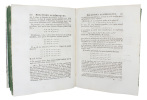"BÉZOUT, (ÉTIENNE). - BÉZOUT'S THEOREM.
Théorie Générale des Équations algebraiques.
Paris, Ph.-D. Pierres, 1779. 4to. Nice recent vellum, titlelabel with gilt lettering on spine. (4),XXVIII,471 pp. Wide-margined, clean and fine.
Reference : 46989
First edition of Bezout's main work - a fundamental contribution to algebraic geometry - in which he prooved the so called ´Bezout's theorem. The theorem was essentially stated by Isaac Newton in his proof of lemma 28 of volume 1 of his Principia, where he claims that two curves have a number of intersection points given by the product of their degrees.Bézout's theorem is a statement in algebraic geometry concerning the number of common points, or intersection points, of two plane algebraic curves. The theorem claims that the number of common points of two such curves X and Y is equal to the product of their degrees. The work stimulated many investigations in the modern theory of elimination, including Cauchy’s refinements of elimination procedure and Sylvester’s work on resultants and inertia forms. Bezout’s theorem is crucial to the study of the intersection of manifolds in algebraic geometry.""It was not until 1779 that Bezout published his Théorie des équations algébriques, his major work on elimination theory. Its best-known achievement is the statement and proof of Bezout’s theorem: ""The degree of the final equation resulting from any number of complete equations in the same number of unknowns, and of any degrees, is equal to the product of the degrees of the equations."" Bezout, following Euler, defined a complete polynomial as one that contains each possible combination of the unknowns whose degree is no more than the degree of the polynomial. Bezout also computed that the degree of the resultant equation is less than the product of the degrees for various systems of incomplete equations. Here we shall consider only the complete case.The proof makes one marvel at the ingenuity of Bezout, who, like Euler, not only could manipulate formulas but also had the ability to choose those manipulations that would be fruitful. He was compelled to justify his nth-order results by a naive ""induction"" from the observed truth of the statements for 1, 2, 3 ···. Also, numbered subscripts had not yet come into use, and the notations available were clumsy.""(DSB).
Bookseller's contact details
Herman H. J. Lynge & Son
William Schneider
Silkegade 11
1113 Copenhagen
Denmark
+45 33 155 335
Payment mode
Sale conditions
All items may be returned for a full refund for any reason within 14 days of receipt.
 Write to the booksellers
Write to the booksellers



